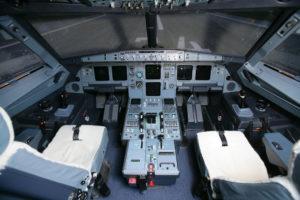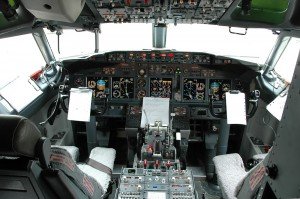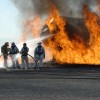The Cockpit
[audio:https://aviationenglishblog.com/wp-content/uploads/2010/09/10thecockpit.mp3|titles=The Cockpit]The Cockpit
The cockpit is the area in the front of the aircraft from where a pilot controls the aircraft. Referred to as flight deck on an airliner, it is basically the driver’s seat. However, the things that go on in a cockpit are far more complicated than what happens behind the wheel. The cockpit comprises of an instrument panel and controls which allow the pilot to fly the aircraft.
The cockpit of an aircraft has undergone a dramatic change over the years. After all the changes, the layout has been standardized today. Modern cockpits are fully computerized and the manual flight control has been replaced by a fly-by-wire system with an electronic interface and the control column with an electronic side-stick.
 In the modern electronic cockpit the following flight instruments are regarded as essential.
In the modern electronic cockpit the following flight instruments are regarded as essential.
– Mode Control Panel (MCP), a long narrow panel located centrally in front of the pilot.
– Primary Flight Display (PFD) located at a prominent central position.
– Navigation Display, adjacent to PFD.
– Throttle levers are used to control the engine power and typically sit in between the pilot and the co-pilot.
– Direction finder, a panel that works as a compass and leads the pilot to the destination, located towards the right of the Navigation Display.
 – Engine Indication and Crew Alerting System that gives relevant information by means of press of a button.
– Engine Indication and Crew Alerting System that gives relevant information by means of press of a button.
– Navigation controls located right at the top that help in maneuvering the plane.
– Radar
– Flight Management System/Control Unit for flight plan, navigation and speed control.
– Back-up instruments at a less prominent part of the cockpit.
Apart from enabling a straighter and shorter path for reduced fuel consumption and saving time, the cockpit of the future envisages conversion of data into a three-dimensional virtual view of the scene outside the aircraft. The graphic representation of the conditions outside the aircraft, the nearby terrain, nearby aircraft and runaway approaches will ensure that even in zero-visibility, thick cloud, total darkness or fog, the pilot will know where he is going as if flying conditions were perfect. Add to that alerts if the approach to landing is unstable or at a risky angle and you have a relatively safer air travel.
 Discussion question:
Discussion question:
1) Which of the 3 cockpits in this post do you prefer. Why do you prefer that particular one?
















Recent Comments